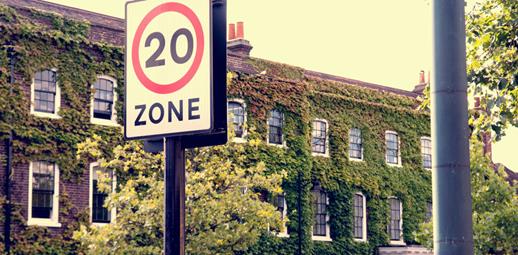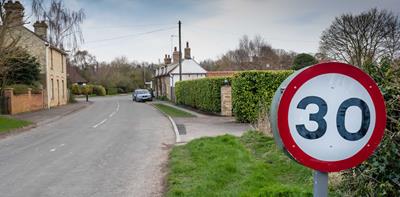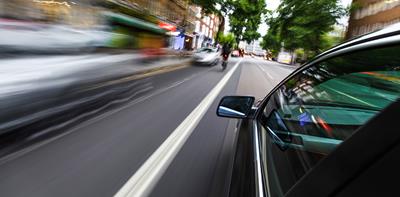
The 30mph speed limit in built-up areas has been standard practice in the UK since 1956. But the view that 20’s plenty is gaining support nationwide.
At some point, it could be the case that a 20mph speed limit will apply to all restricted roads. And what’s classed as a ‘restricted road’? You can usually recognise these roads because they have a system of street lights no more than 200 yards apart. These tend to be in built-up or residential areas, where there are often a high number of pedestrians.
But how long will it be until we have to apply the brakes further? Here we’ll look at the current state of play in England, Wales, Scotland and Northern Ireland.
Why is 20mph preferable to 30mph?
Put simply, 20mph is safer. The objective of lowering the speed limit is to reduce deaths and serious injuries on our roads.
Several studies have been conducted into the chances of being injured when being knocked over at different speeds. While the exact risk level varies between studies, it’s agreed that there’s a much greater chance of a pedestrian being killed at 30mph than at 20mph[1].
For example, one study conducted in Bristol between 2008 and 2016 showed that introducing 20mph speed limits reduced fatalities by around 63% city-wide[2].
In addition to improving safety levels, reducing the speed limit has environmental benefits. Some studies have shown a correlation between 20mph speed limits and a reduction in pollution[3], which further strengthens the case for wider adoption.
Don’t we already have 20mph speed limits?
There are already plenty of local 20mph zones. These are often designated by local councils to protect vulnerable road users, such as children or cyclists. For instance, it’s common for roads near schools to have 20mph speed limits and there may also be traffic-calming measures such as speed bumps in these zones.
In fact, around 21 million people[4] – that’s almost a third of people in the UK – live on 20mph roads, or roads where a 20mph speed limit has been agreed. And this rises to over half in London.
So slowly but surely, more of these limits are being introduced.
Here are the current boroughs with 20 MPH in place, and a map for more details.
20mph speed limits in England
At the time of writing, the government has no plans to make 20mph the residential speed limit nationwide. However, this puts it out of step with two devolved nations – Wales and Scotland (see below).
In addition, campaigners are urging a change of approach in urban areas. Leading the charge is TRL – formerly the Transport Research Laboratory – a government-appointed team of engineers, scientists and specialists. The group is pushing for drivers to view 20mph as the assumed maximum speed limit.
Wales
In Wales, trials of the 20mph default speed limit have already begun, with a view to all residential areas adopting this limit by some time in 2023[5].
The first two pilots started in St Brides Major in the Vale of Glamorgan, and St Dogmaels in Pembrokeshire, and this trial scheme is gradually being extended. The data gathered will help to inform future decisions regarding setting limits.
Scotland
The proposed Restricted Roads (20 mph Speed Limit) (Scotland) Bill aims to make 20mph the limit on most urban and residential roads in Scotland[6]. This followed evidence showing that a 20mph speed limit led to a reduction in accidents and lower emissions in neighbourhoods in Edinburgh.
While this won’t apply to all residential roads, as will be the case in Wales, it’s expected that 20mph will become the norm in built-up areas.
Northern Ireland
While there are currently no formal plans for a reduction to 20mph limits in built-up areas in Northern Ireland, local initiatives are proving popular. A successful scheme to roll out 20mph limits to roads around 103 schools in Belfast led to the announcement of a second phase in September 2021[7]. A further 106 schools were added to the scheme, bringing the total to 209.
It's fair to say that in many cases, throughout the UK, 20mph speed limits are coming to a road near you.
To read more about driving and road safety go to Solved.
[1] https://www.rospa.com/media/documents/road-safety/20mph-zones-and-speed-limits-factsheet.pdf
[2] https://injuryprevention.bmj.com/content/26/1/85
[3] https://gov.wales/sites/default/files/publications/2019-08/the-state-of-the-evidence-on-20mph-speed-limits-with-regards-to-road-safety-active-travel-and-air-pollution-impacts-august-2018.pdf
[4] https://www.thetimes.co.uk/article/millions-now-parked-in-a-20-zone-3g739cc2x
[5] https://www.bbc.com/news/uk-wales-57749015
[6] https://archive2021.parliament.scot/parliamentarybusiness/currentcommittees/110202.aspx
[7] https://www.infrastructure-ni.gov.uk/news/mallon-announces-further-roll-out-20mph-speed-limit-schemes-106-schools


